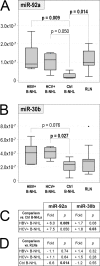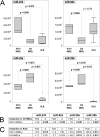microRNA levels in paraffin-embedded indolent B-cell non-Hodgkin lymphoma tissues from patients chronically infected with hepatitis B or C virus
- PMID: 25236768
- PMCID: PMC4160900
- DOI: 10.1186/1471-2334-14-S5-S6
microRNA levels in paraffin-embedded indolent B-cell non-Hodgkin lymphoma tissues from patients chronically infected with hepatitis B or C virus
Abstract
Background: Epidemiological evidence links Hepatitis B Virus (HBV) and Hepatitis C Virus (HCV) to B-cell non-Hodgkin lymphoma (B-NHL). These B-NHLs, particularly those associated with HCV, may represent a distinct sub-group with peculiar molecular features, including peculiar expression of microRNAs (miRs).
Methods: Fourteen formalin fixed paraffin embedded (FFPE) tissues from HBV+, HCV+ and HBV-/HCV- indolent B-NHL patients were analyzed for levels of 34 selected miRs by quantitative Real-Time PCR. Reactive lymph nodes (RLNs) from HBV-/HCV- patients were included as non-tumor control. Statistical analysis of output data included Pearson and Spearman correlation and Mann-Whitney test and were carried out by the STATA software.
Results: MiR-92a was decreased exclusively in HBV-/HCV- B-NHLs, while miR-30b was increased in HBV+ and HCV+ samples, though only the HCV+ achieved full statistical significance. Analysis of a small subset of B-NHLs belonging to the same histological subtype (Nodal Marginal Zone Lymphoma) highlighted three miRs associated with HCV infection (miR-223, miR-29a and miR-29b) and confirmed decreased level of miR-92a in HBV-/HCV- samples also when considering this restricted B-NHL group.
Conclusions: Although caution is needed due to the limited number of analyzed samples, overall the results suggest that differences at the miR expression level exist between indolent B-NHLs developed in patients with or without HBV or HCV infection. The identification of three further miRs associated with HCV by analyzing histologically homogeneous samples suggests that variations of miR levels possibly associated with HBV or HCV may be obscured by the tissue-specific variability of miR level associated with the different histological subtypes of B-NHL. Thus, the identification of further miRs will require, in addition to an increased sample size, the comparison of B-NHL tissues with the same histological classification.
Figures


Similar articles
-
Viral genomes and antigen detection of hepatitis B and C viruses in involved lymph nodes of Egyptian non-Hodgkin's lymphoma patients.Egypt J Immunol. 2006;13(1):105-14. Egypt J Immunol. 2006. PMID: 17974155
-
Hepatitis C and B virus infections in hepatocellular carcinoma. Analysis of direct detection of viral genome in paraffin embedded tissues.Cancer. 1996 May 1;77(9):1787-91. doi: 10.1002/(SICI)1097-0142(19960501)77:9<1787::AID-CNCR5>3.0.CO;2-9. Cancer. 1996. PMID: 8646675
-
Prevalence of hepatitis B or C virus infections in patients with non-Hodgkin's lymphoma.J Gastroenterol Hepatol. 2001 Feb;16(2):215-9. doi: 10.1046/j.1440-1746.2001.02406.x. J Gastroenterol Hepatol. 2001. PMID: 11207904
-
miRNAs as Potential Biomarkers for Viral Hepatitis B and C.Viruses. 2020 Dec 14;12(12):1440. doi: 10.3390/v12121440. Viruses. 2020. PMID: 33327640 Free PMC article. Review.
-
Complex interactions between microRNAs and hepatitis B/C viruses.World J Gastroenterol. 2014 Oct 7;20(37):13477-92. doi: 10.3748/wjg.v20.i37.13477. World J Gastroenterol. 2014. PMID: 25309078 Free PMC article. Review.
Cited by
-
HBV-associated DLBCL of poor prognosis: advance in pathogenesis, immunity and therapy.Front Immunol. 2023 Jul 7;14:1216610. doi: 10.3389/fimmu.2023.1216610. eCollection 2023. Front Immunol. 2023. PMID: 37483605 Free PMC article. Review.
-
MicroRNA expression in hepatitis C virus-related malignancies: A brief review.World J Gastroenterol. 2015 Jul 28;21(28):8562-8. doi: 10.3748/wjg.v21.i28.8562. World J Gastroenterol. 2015. PMID: 26229398 Free PMC article. Review.
-
[Analysis of clinical characteristics and prognostic factors in patients with non-Hodgkin lymphoma and HBV infection].Zhonghua Xue Ye Xue Za Zhi. 2018 Jul 14;39(7):563-568. doi: 10.3760/cma.j.issn.0253-2727.2018.07.007. Zhonghua Xue Ye Xue Za Zhi. 2018. PMID: 30122015 Free PMC article. Chinese.
-
Hepatitis C virus - associated B cell non-Hodgkin's lymphoma.World J Gastroenterol. 2016 Jul 21;22(27):6214-23. doi: 10.3748/wjg.v22.i27.6214. World J Gastroenterol. 2016. PMID: 27468211 Free PMC article. Review.
-
The Relevance of MicroRNAs in the Pathogenesis and Prognosis of HCV-Disease: The Emergent Role of miR-17-92 in Cryoglobulinemic Vasculitis.Viruses. 2020 Nov 29;12(12):1364. doi: 10.3390/v12121364. Viruses. 2020. PMID: 33260407 Free PMC article.
References
-
- Kuniyoshi M, Nakamuta M, Sakai H, Enjoji M, Kinukawa N, Kotoh K, Fukutomi M, Yokota M, Nishi H, Iwamoto H, Uike N, Nishimura J, Inaba S, Maeda Y, Nawata H, Muta K. Prevalence of hepatitis B or C virus infections in patients with non-Hodgkin's lymphoma. J Gastroenterol Hepatol. 2001;14:215–219. - PubMed
-
- Iwata H, Matsuo K, Takeuchi K, Kishi Y, Murashige N, Kami M. High incidences of malignant lymphoma in patients infected with hepatitis B or hepatitis C virus. Haematologica. 2004;14(3):369–370. - PubMed
-
- Mele A, Pulsoni A, Bianco E, Musto P, Szklo A, Sanpaolo MG, Iannitto E, De Renzo A, Martino B, Liso V, Andrizzi C, Pusterla S, Dore F, Maresca M, Rapicetta M, Marcucci F, Mandelli F, Franceschi S. Hepatitis C virus and B-cell non-Hodgkin lymphomas: an Italian multicenter case-control study. Blood. 2003;14(3):996–999. - PubMed
-
- Marcucci F, Mele A, Spada E, Candido A, Bianco E, Pulsoni A, Chionne P, Madonna E, Cotichini R, Barbui A, De Renzo A, Dore F, Iannitto E, Liso V, Martino B, Montanaro M, Pagano L, Musto P, Rapicetta M. High prevalence of hepatitis B virus infection in B-cell non-Hodgkin's lymphoma. Haematologica. 2006;14:554–557. - PubMed
-
- Hjalgrim H, Engels EA. Infectious aetiology of Hodgkin and non-Hodgkin lymphomas: a review of the epidemiological evidence. J Intern Med. 2008;14(6):537–548. - PubMed
Publication types
MeSH terms
Substances
LinkOut - more resources
Full Text Sources
Other Literature Sources
Medical
Molecular Biology Databases

